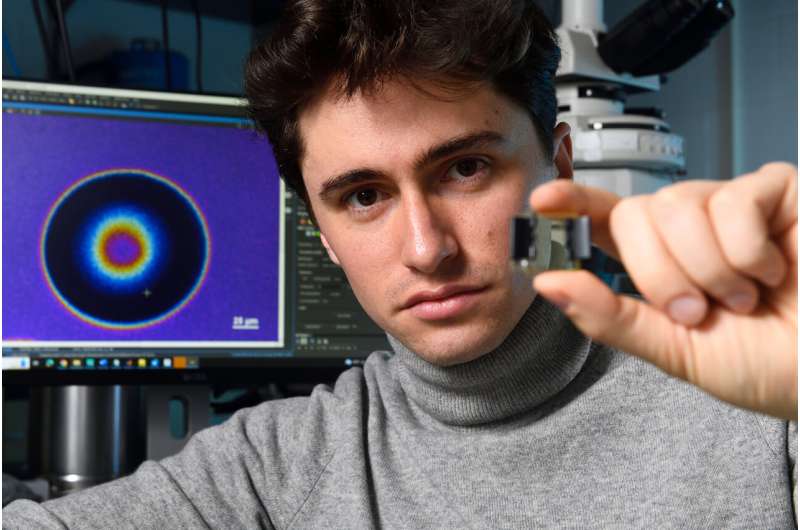This article has been reviewed according to Science X's editorial process and policies. Editors have highlighted the following attributes while ensuring the content's credibility:
fact-checked
peer-reviewed publication
trusted source
proofread
A key to the future of robots could be hiding in liquid crystals

Robots and cameras of the future could be made of liquid crystals, thanks to a new discovery that significantly expands the potential of the chemicals already common in computer displays and digital watches.
The findings, a simple and inexpensive way to manipulate the molecular properties of liquid crystals with light exposure, are now published in Advanced Materials.
"Using our method, any lab with a microscope and a set of lenses can arrange the liquid crystal alignment in any pattern they'd want," said author Alvin Modin, a doctoral researcher studying physics at Johns Hopkins. "Industrial labs and manufacturers could probably adopt the method in a day."
Liquid crystal molecules flow like a liquid, but they have a common orientation like in solids, and this orientation can change in response to stimuli. They are useful in LCD screens, biomedical imaging instruments, and other devices that require precise control of light and subtle movements. But controlling their alignment in three dimensions requires costly and complicated techniques, Modin said.
The team, which includes Johns Hopkins physics professor Robert Leheny and assistant research professor Francesca Serra, discovered they could manipulate the three-dimensional orientation of liquid crystals by controlling light exposures of a photosensitive material deposited on glass.
They shined polarized and unpolarized light at the liquid crystals through a microscope. In polarized light, light waves oscillate in specific directions rather than randomly in all directions, as they would in unpolarized light. The team used the method to create a microscopic lens of liquid crystals able to focus light depending on the polarization of light shining through it.
First, the team beamed polarized light to align the liquid crystals on a surface. Then, they used regular light to reorient the liquid crystals upward from that plane. This allowed them to control the orientation of two types of common liquid crystals and create patterns with features the size of a few micrometers, a fraction of the thickness of a human hair.
The findings could lead to the creation of programmable tools that shapeshift in response to stimuli, like those needed in soft, rubberlike robots to handle complex objects and environments or camera lenses that automatically focus depending on lighting conditions, said Serra, who is also an associate professor at the University of Southern Denmark.
"If I wanted to make an arbitrary three-dimensional shape, like an arm or a gripper, I would have to align the liquid crystals so that when it is subject to a stimulus, this material restructures spontaneously into those shapes," Serra said. "The missing information until now was how to control this three-dimensional axis of the alignment of liquid crystals, but now we have a way to make that possible."
The scientists are working to obtain a patent for their discovery and plan to further test it with different types of liquid crystal molecules and solidified polymers made of these molecules.
"Certain types of structures couldn't be attempted before because we didn't have the right control of the three-dimensional alignment of the liquid crystals," Serra said. "But now we do, so it is just limited by one's imagination in finding a clever structure to build with this method, using a three-dimensional varying alignment of liquid crystals."
More information: Alvin Modin et al, Spatial Photo‐Patterning of Nematic Liquid Crystal Pretilt and its Application in Fabricating Flat Gradient‐Index Lenses, Advanced Materials (2024). DOI: 10.1002/adma.202310083
Journal information: Advanced Materials
Provided by Johns Hopkins University





















